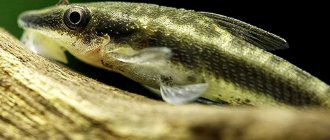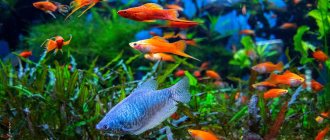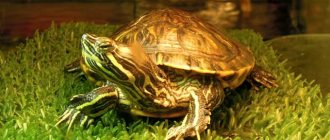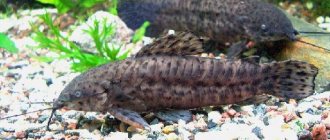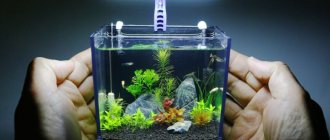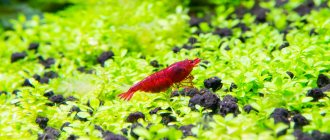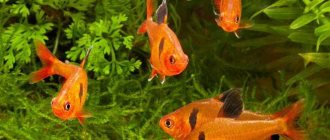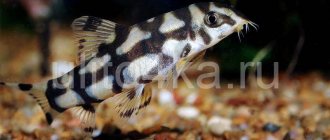Aquarium cleaner No. 1. Ancistrus (chain catfish)
This type of fish has many colors and sizes, but all representatives of the species are exclusively herbivores, feed on algae and greens, and get along well with other types of fish.
Some subspecies of ancistrus grow to large sizes, require protein feeding and can eat live plants in case of lack of food.
https://www.youtube.com/watch?v=tE_TQZPigZ4
They are best suited as bottom food collectors. Adult catfish develop antennae, sometimes even in females.
Small size and good nature are the hallmarks of this omnivorous species. Chain catfish need snags to hide inside and hunt for food. Greens are not the main source of nutrition. In the aquarium can be used to clean the day. Clown catfish are popular; they feed on protein and plant foods, but collect food from snags. Therefore, the aquarium must have this item.
Description of Ancistrus
The body shape is teardrop-shaped. On top it is covered with a shell of keratinized plates.
Adult ancistrus grow up to 10 cm in an aquarium. The maximum body length depends on the temperature of the content; the higher it is, the smaller the size of the ancistrus.
Blue catfish (Ancistrus dolichopterus).
When kept in aquariums, several new forms of Ancitrus were obtained.
In addition to the ordinary ancistrus, there is a veil form, the distinctive feature of which is a long tail and enlarged fins. As always, there are albinos. A star-shaped ancistrus with well-defined white dots on a dark body has also been bred.
Selection and arrangement of an aquarium
Aquarium catfish is an unpretentious fish. To keep it at home you will need a spacious aquarium with a wide bottom. The only important condition is that the water in the container must be replaced on time and there must be a good filtration system.
You should choose a home pond depending on the size of the aquarium fish that will live in it. If for small species of catfish a container with a volume of 50–200 liters is sufficient, then for larger representatives the minimum tank volume is 300 liters.
We suggest you read: How to prepare an aquarium for fish
Decor
The aquarium should have houses for fish, since without shelter they will be uncomfortable. Usually, to do this, there should be enough driftwood and stones in the aquarium so that the catfish can hide under them during the day and have a good rest before dusk. Since most catfish lead a solitary lifestyle, without good shelter they can suffer greatly.
Aquarium catfish should be kept in clean, filtered, unsalted water, as in nature they prefer fresh water bodies. The liquid temperature should be 22–28 °C. Thanks to cutaneous respiration and the ability to breathe ordinary air, catfish rise to the surface, filling their lungs. This quality makes the fish unpretentious to the oxygen regime.
Lighting
Most catfish living at home choose the dark time of day to stay awake. Therefore, there is no need to additionally supply the aquarium with lighting devices. They are comfortable with dim light, and if it is possible to provide them with constant partial shade, then the fish will be able to swim out during the daytime.
Plants
It is recommended to choose vegetation depending on the type of catfish that will live in the aquarium. For vegetarian fish that eat exclusively plant foods, it is better to organize plantings of artificial algae. Natural ones will be eaten very quickly. Of living plants, only representatives with a good root system, such as cryptocorynes and echinodorus, are suitable.
Aquarium catfish are not picky when it comes to choosing soil. Some species that like to “comb” the bottom of the container raise clouds of turbidity if it is covered with sand. For them it is better to choose coarse-grained soil. The only exception is gravel, which can damage the fish's abdomen and antennae.
Maintenance and care, design of the aquarium
The minimum aquarium size for a group of 6–8 fish starts from 40 liters. The design should provide for a variety of shelters, for example, in the form of driftwood and other decorative elements, as well as areas with dense vegetation. Natural wood objects (roots, branches) will serve not only as a natural decoration, but also as a basis for the growth of algae - an additional source of food. Otherwise, it is a very unpretentious species, provided it is kept in stable water conditions and regular maintenance of the aquarium (water changes and removal of organic waste).
Aquarium cleaner No. 3. Sevelia lined (mountain stream loach)
The fish eat algae, live in groups, and have a unique and unusual appearance. To live, they need a powerful flow of clean water and the absence of aggressive individuals of other species in the aquarium. In a pond, vines are an addition to the existing team of cleaners that cannot cope with the greenery.
Externally, Sevelia has a lined body shape that resembles a guitar, and these fish are often confused with catfish. In nature, representatives of the species live in mountain streams, hide in rocks, and move by clinging to surfaces. To survive, loaches need oxygenated water; they do not tolerate pollution and uncooperative neighbors. They feed on algae and the remains of food that has sunk to the bottom of the aquarium.
Otocinclus
Like other cleaner catfish from the chainmail family, nature provided Otocinclus with a mouth of a special structure - in the form of a powerful suction cup. The rough inner surface of the mouth and powerful jaw muscles help it easily scrape algae from any surface.
The merits of this small, modest and slightly timid fish were highly appreciated by the “guru” of all aquarists, Takashi Amano. It is she who recommends placing it in a new aquarium with plants immediately upon startup, since outbreaks of an increase in the number of diatoms are very often observed there. If proper measures are not taken, all surfaces in the aquarium will soon be covered with a slimy brown-brown mass.
But otocinclus does not need better food - they selflessly eat diatoms from surfaces and do not disdain green algae. True, these sucker catfish have a peculiarity - they often choose plant leaves for food and avoid the walls of the aquarium.
Description of the fish and contents
Otocinclus are literally small representatives of the large and varied in size family of chainmails, their length rarely reaches more than 6 cm. They do not have a particularly remarkable coloring - a dark back and a light belly, transparent fins, an elongated body and, of course, they have a mustache - like a real catfish. Of the 20 species of otocinclus, aquarists are most fond of affinis, negros, macrospilus, arnoldi, and coma.
Cleaner catfish are nocturnal fish; they prefer diffused light; during the daytime they stay near the bottom, near shelters (you should worry about their arrangement in advance). We should not forget that otocinclus are schooling fish; they need at least a minimum “company” of 5–7 individuals. Such a flock can keep a 100-liter aquarium clean.
Otocinclus are peaceful creatures and can be good neighbors for red neons, cichlids, guppies and other peaceful small fish.
These aquarium orderlies love cleanliness, daily water changes of about a third, filtration and aeration are a must for them. It is also necessary to monitor the level of nitrates (no more than 10.0 mg/l). Otherwise, the requirements for the conditions of keeping fish are not strict.
In a clean aquarium, cleaners are fed artificial food based on algae, scalded spinach, lettuce, and blanched zucchini.
Content
As a rule, ancistrus are not kept alone; they are planted in groups of several individuals in an aquarium as cleaners. Keeping these catfish is quite simple. These are peaceful fish that get along well with almost all fish kept in tropical freshwater aquariums.
We suggest you read: Loricarids general rules for keeping in a home tropical aquarium
Ancistrus survive well in strong currents and can live in fast-flowing waters, clinging to stones and snags.
In an aquarium with catfish, suction cups maintain the temperature within 22-26 degrees. But they are able to withstand temperature fluctuations from 18 to 33 degrees. Catfish have adapted to live in aquariums with almost any water composition, although in natural conditions they prefer slightly acidic water. Ancistrus love clean water with a high oxygen content, so intensive aeration is recommended.
Plants should grow quite densely in the aquarium. It is also necessary to arrange various shelters for ancistrus, in which catfish like to hide. It is desirable to have stones and snags that the ancistrus will happily scrape off.
The oral sucker has keratinized tubercles, like a grater, designed for scraping and eating plant and animal “growths” on the surface of various objects.
Males exhibit territorial behavior and actively defend their favorite hiding places. Ancistrus activity peaks in the evening. They eat a variety of fouling from numerous surfaces in the aquarium. If there is not enough food, catfish can begin to spoil the plants, especially young shoots. They partially eat the leftover food left by other inhabitants of the aquarium.
If there is a group of catfish, or they live in small aquariums, the pets need additional feeding with plant foods. As such food, they can be given cabbage or salad scalded with boiling water. You can also use ready-made food for herbivorous fish in tablet form.
Caring for catfish in an aquarium will not cause much trouble for the owner. An important condition for the survival of these fish is timely feeding. If the reservoir is equipped with shelters, algae grows, and a comfortable temperature and water hardness are ensured, then caring for them is a pleasure.
What to feed catfish
Feeding catfish will also not cause much trouble for the owner. If there are other fish in the aquarium, there is no need to feed the catfish specially. They perfectly feed on the remains of food lying on the bottom, while simultaneously cleaning it, so you don’t have to specially feed them. Pieces of fish, shrimp and flakes sold in pet stores are ideal food for aquarium catfish.
Catfish eats
The largest representatives living in nature can live up to 100 years, but domestic fish are not so long-lived. Depending on the type of catfish and the conditions of its keeping, the average lifespan of catfish is 8 years, provided that aquarium catfish live in suitable conditions.
The mouth of these catfish has the shape of a suction cup; it allows the fish to attach to the substrate and scrape algae from it. Ancistrus love currents and clean, oxygenated water. The optimal temperature for them is 20-30℃, hardness up to 20°, ph 6-7.5.
In an aquarium with these catfish, it is necessary to install a filter and a compressor, since these catfish breathe oxygen dissolved in water. A partial water change of approximately 10-20% of the volume is advisable weekly.
Habitat
Comes from South America from the territory of Peru.
It is found in the basins of the Ucayali (lower reaches) and Marañon rivers up to the mouth. They live in the main riverbeds and their tributaries, preferring areas with slow flows. They stay close to the shore among dense aquatic vegetation. Brief information:
- Aquarium volume - from 40 liters.
- Temperature - 21–25°C
- pH value – 6.0–7.5
- Water hardness - soft (2–10 dGH)
- Substrate type - any
- Lighting - moderate
- Brackish water - no
- Water movement is weak
- The size of the fish is about 4 cm.
- Diet: plant foods only
- Temperament - peaceful
- Keep a group of at least 6–8 individuals
Aquarium cleaner No. 4. Otocinclus (dwarf catfish)
Small fish love greens, but do not tolerate stress well and need plenty of food to live a full life. With a lack of food, they begin to starve and die.
We suggest you read: How to make a biofilter for an aquarium with your own hands
The appearance of the fish is decorated with black lines on a brown-gray background, but other brighter colors are also found. Otocinclus clears greenery from plants without damaging the structure of the plantings. Picky and sensitive dwarf catfish need a stable and healthy ecology of the reservoir, they live in groups and do not tolerate loneliness.
Compatibility with other fish
When buying fish, you need to know exactly who the catfish get along with in the aquarium, because each species has its own preferences.
In life, these catfish are very peaceful, they do not start fights with other inhabitants of the reservoir, but they can conflict with each other. The only threat to them comes from large fish, for example, large astronotus, which are capable of swallowing their prey whole.
Some species of speckled catfish will not get along with tail-biting fish.
Catfish are not compatible with small fish such as guppies or neons - they can become food for predators. It is better to add herbivorous species of catfish to such neighbors.
Ancistrus can be kept with any fish, except for large predators with powerful jaws (such as piranhas). When kept with other sucker catfish, it is necessary to ensure that all catfish have enough food. If there is a shortage of food, small fights may occur between them.
As a food supplement, such catfish are often given cut fresh cucumber. It is lowered to the bottom with the help of some kind of weight and left for several hours. Residues must be removed, otherwise they will spoil the water.
Place natural driftwood in the aquarium with cleaners, previously boiled in a saline solution and washed well. The fact is that by polishing its surface with their suction cup mouth, ancistrus receive the cellulose they need so much. But its lack leads to stunted growth and pathology in the formation of shell scales.
With proper care, Ancistrus catfish live in an aquarium for up to 7-8 years. There are cases when they lived longer than 10 years.
Breeding
The ancistrus catfish reproduces independently in captivity, and the only thing it needs is to provide good shelter, and also to add more females to the males. If there are fewer of the latter than the former, the males will start fighting for control of the territory. In addition, males can eat eggs laid in the opponent’s territory.
Before breeding catfish, you need to understand if the fish has a pair. The external sexual characteristics of ancistrus will help you figure this out. Males are distinguished from females by the presence of horns on their heads. Another characteristic feature is that males are larger than females, while the latter look thicker.
A sign that the male is ready to reproduce is his behavior: the fish cleans the shelter and drives other inhabitants of the aquarium out of it. Having finished arranging the territory, the male attracts the female with blows of his tail. Having examined the place, the female lays eggs on the walls of the substrate, after which the male inseminates and begins to protect the future fry.
As soon as the female spawns, she can be removed, since she has already fulfilled her function. If there are several females in the tank, and they also laid eggs in the same shelter, the male will guard the eggs of each of them.
The eggs ripen within a week. The male guards the emerging fry until they are able to move around the aquarium on their own. After this, it is recommended to place the male in another tank. You can feed the fry with ciliates, as well as specialized foods, adding egg yolk to them. You can also diversify the diet of small fish with food for shrimp, and later provide plant food for mature ancistrus individuals.
In an aquarium with fry, the water needs to be renewed by 20% every day.
Reproduction
You can stimulate the reproduction of catfish by lowering the water temperature in the aquarium. The spawning period lasts up to 5 days, and during this time the female and several males must be transplanted into a spawning tank - a special container with a volume of 30 to 70 liters. You can also breed fish in a plastic basin if there is no other free container.
Catfish fry
The main thing is to correctly determine the sex of the fish. It is usually not difficult to distinguish a female from a male; the male has a brighter color and a slender body. Changes in water temperature accelerate the onset of spawning. Courtship lasts about 1 week, while the male tries to show himself in all his glory. He circles around the lady, trying to arouse her interest. When the female pays attention to him, the male touches her with his antennae, indicating his readiness to reproduce.
Types and their colors
Many species of catfish are popular among both beginning amateur aquarists and professionals. Representatives of some species are valued for their harmless and peaceful disposition, others for their bright and exotic colors, and others for their bizarre body shapes. Below are the names of the most popular species of aquarium catfish.
Agamix or star catfish is one of the most unpretentious varieties of aquarium catfish, easily getting along with almost all types of fish (with the exception of large cichlids). Body sizes of adults vary from 10 to 12 centimeters in length. These creatures have a powerful and slightly elongated body, a large triangular head.
Corydoras is a genus of representatives of the catfish order, found in its natural habitat in the Amazon and Orinoco river basins. In total, about 150 species of these small, peace-loving fish are known.
Pygmy is a dwarf representative of the Corydoras genus, whose body length is only 2-2.5 centimeters. This fish has a graceful elongated body, a humpbacked back and a two-lobed caudal fin with pointed ends. The fins are transparent, grayish in color. The body color of the Pygmy Corydoras is silver-gray or grayish-brown.
The leopard catfish is another attractive little member of the Corydoras genus. The body size of adult individuals is about 6 centimeters. The fish have a very remarkable leopard-print color: their entire grayish-yellow body is decorated with numerous black sinuous patterns. Along the central line of the body of leopard catfishes there are three dark lines consisting of dark dots and strokes.
Venezuela orange is a very spectacular representative of the Corydoras genus, notable for its bright colors, peaceful and good-natured disposition. The body length of Venezuelan orange corydoras does not exceed 7.5 centimeters. The fish have a very attractive color, combining gray-turquoise and juicy orange colors. The dorsal and caudal fins are transparent, pale orange. The head is painted gray-turquoise with purple strokes.
The Siamese killer whale is a freshwater aquarium catfish whose size does not exceed 12 centimeters. This fish is distinguished by its mobility and energy. When kept in an aquarium with other fish, it rarely shows aggression. However, being a predator, the Siamese killer whale still poses a threat to small aquarium fish and fry.
Panak is a spectacular freshwater representative of chain catfish. The body length of these fish, depending on the species, can vary from 7.5 to 40 or more centimeters. The back and sides of panakas are covered with dark-colored bone plates. The dorsal and pectoral fins are studded with sharp spines. These fish lead a bottom-dwelling lifestyle, hiding in shelters during the day and hunting at night. Panakas, being predators, pose a threat to small fish. However, they do not disdain algae and the remains of invertebrate animals.
The anchor catfish is a fairly unpretentious miniature representative of catfish, whose body length does not exceed 3 centimeters. The outline of his body visually resembles an anchor. Color varies from light coffee to dark brown. These fish have a very peaceful and calm disposition and get along well with other types of fish of a similar size.
We suggest you read: How snails reproduce in an aquarium: how they mate, how they give birth, how they reproduce
Emerald brochis is a very attractive representative of armored catfish. The body size of an adult is about 8 centimeters. The fish has a beautiful color, transitioning from a soft emerald color on the back to a light beige shade on the belly. Brochis are schooling fish, so they should be kept in a number of several individuals in the aquarium.
Synodontis Dalmatian is a very impressive aquarium catfish that, with proper care, can live for about 15 years. The body size of adult individuals can reach 20 centimeters. The fish has an elongated, graceful, light-colored body with dark spots. The tips of the fins have a bluish tint. Dalmatian catfish are considered excellent aquarium cleaners.
The jaguar synodont is another beautiful representative of the catfish order, found in the wild in the freshwater areas of West Africa. Notable for its white-golden color, diluted with a marbled pattern of brown stripes. The fish can reach a length of 12-18 centimeters.
Gunther's catfish, Peacock catfish or Peacock's eye is an elegant and agile fish, unpretentious to the conditions of detention. It has a slightly elongated body of gray-silver color with a spectacular mark near the gills, reminiscent of the spot on a peacock’s tail. There are 4 pairs of antennae in the mouth area. When breeding these catfish, it should be taken into account that they are schooling.
The sacbranch catfish is a large predatory fish, growing up to 30-40 centimeters in artificial conditions. Its amazing feature is the presence of two primitive lungs, which allow the fish to survive in the absence of water for several hours. Body color varies from brown-black to pale brown.
Otocinclus is a small representative of the catfish family, especially valued among aquarists. This fish is an active algae eater that helps keep the aquarium clean. Their body sizes can vary from 2.5 to 5.5 centimeters. Body color is golden brown. The upper part of the body in the head area is painted marsh brown. A dark stripe runs along the body on both sides. The average lifespan of otocinclus is about 5 years.
Gerinocheilus yellow or chanterelle catfish is a small freshwater fish that grows up to 12-15 centimeters in aquarium conditions. Body color is light or rich yellow. A characteristic feature of these fish is their suction cup mouth, with which they clean the aquarium of algae. However, as adults, these creatures can pose a threat to the rest of the inhabitants of the aquarium. By attaching itself to the body of another fish, Gerinocheilus can cause fatal damage to it.
Pirara or red-tailed catfish is one of the oldest species of large catfish, capable of reaching two meters in length in its natural habitat. The fish is notable for its interesting coloring. The back of this catfish can be brown, terracotta or almost black. The sides are painted a pale yellow, the belly is white.
The striped platidoras or singing catfish is one of the most beautiful fish, especially popular among aquarists. They are peaceful, hardy, calm. However, their unique feature lies in their ability to make unusual sounds. Striped platidoras tolerate harsh environmental conditions without problems. In addition, they easily get along with other non-aggressive medium-sized fish.
Olive catfish is a large freshwater fish of the Iktaluridae family. The body length of an adult individual can reach 1.6 meters, and therefore these predatory creatures are usually raised not in decorative, but in public aquariums. The traditional color is solid olive-gray. The belly is colored pearl gray. Long gray whiskers around the wide mouth give these fish a slightly intimidating, but very expressive appearance.
Brachyplatistoma or tiger catfish is a large carnivorous predator that feeds on fish and large crustaceans. When kept in an artificial environment, it requires a lot of free space. The coloring of this spectacular fish, combining dark and light stripes, is reminiscent of a tiger skin. The tiger catfish has an elongated curved body, a flattened and slightly wedge-shaped head.
Aquarium cleaner No. 7. Caridina shrimp
The small-sized crustacean is safe for plants; it lives in colonies; it is advisable not to put it in an aquarium with predators.
The size and often lack of pigmentation make this species of living creatures almost invisible to the eye. Caridins are suitable for small bodies of water with friendly fish, and, best of all, without other living creatures. Read more about shrimp in a separate article.
More materials about aquariums
Which catfish clean the aquarium better?
Among aquarium cleaner catfishes, the Plecostomus family is represented by a huge number of subspecies. Under natural conditions, they are found in rivers flowing through Central and South America. They can be found not only in freshwater bodies of water, but also at the mouths of rivers with brackish water.
They have adapted to low-oxygen waters and thrive in fast-flowing streams at high altitudes. This allows them to be kept in artificial conditions along with a wide variety of fish species.
The aquarium catfish plecostomus is one of the unique tropical fish. This species has an attractive color and does an excellent job of cleaning up even the most neglected aquariums. It is the same age as dinosaurs, so evolutionarily it has developed a high threshold for adaptation to various conditions.

